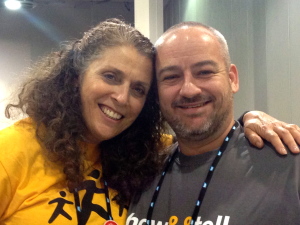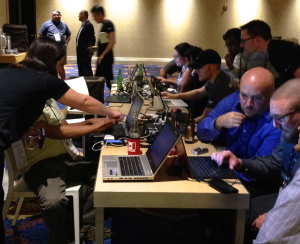
Walking down one of the cavernous halls at the Palazzo hotel in Las Vegas, we approached one of my Enterprise Irregular (EI) colleagues, David Dobrin. Dobrin looked surprised to see me and said, “What are you doing here?” I said, “I’m here to learn!”
Yes, I attended my first SAP TechEd this week and this is where learning happens. TechEd is in four cities around the world this year: Shanghai: March 13–14, 2014, Las Vegas: October 20–24, 2014, Berlin: November 11–13, 2014 and Bangalore: March 11–13, 2015. An “elder” explained to me that TechEd is the physical manifestation of the online community that lives 24/7 around the world in SAP’s SCN community. The earliest form of SAP’s SCN was launched in 2002. The community has shape-shifted over the years to become the glue that ties together customers, mentors, evangelists, partners, and every member of the SAP ecosystem.
I was encouraged to attend TechEd by everyone’s favorite community host and star community advocate, Marilyn Pratt. Between Marilyn and another one of my EI brethren, Craig Cmehil, the inimitable SAP evangelist, I knew I’d be in good hands to learn as much as possible from the community who turns out for SAP TechEd. As a newbie to the space, my challenge for this trip was to get a better understanding of all things big data and data science. My hosts, Mike Prosceno and Andrea Kaufmann did a fantastic job lining me up with SAP experts with whom I could share ideas and get a better understanding of how SAP was solving customer problems with big data via its HANA platform.
So what did I learn?
On Tuesday, I tagged along with Marilyn who was introducing Megan McGuire, lead for Médecins Sans Frontières/Doctors Without Borders (MSF)‘s new eHealth Unit, to various individuals and groups within the SAP community. The goal was to see  how SAP’s technology could further assist McGuire in her ambitious aim to provide timely, accurate information, monitoring, and accessibility for all MSF projects in 26 countries. The challenges associated with data collection, language differences, data formats, even stable connectivity in remote regions all complicate MSF’s goals of going “digital.” In understanding the complexity of the work MSF set out to achieve, I could see easily how this could translate to any large organization. What was particularly interesting to me in the MSF approach was its emphasis on design thinking to frame the approach. MSF’s strategy was designed in collaboration with ThoughtWorks which has an emphasis on disruptive technology for social good and change. In the evening, McGuire was treated to the talents of about 75 SAP developers who formed teams and participated in a 4-hour data visualization challenge using MSF data and SAP’s Lumira data visualization tool. Although I didn’t participate on a team, I was encouraged by how quickly the teams – many of whom had never used SAP’s Lumira – were able to start finding insights in the data. Again, getting a real-time view into the challenges associated with data formats provided a number of teaching moments.
how SAP’s technology could further assist McGuire in her ambitious aim to provide timely, accurate information, monitoring, and accessibility for all MSF projects in 26 countries. The challenges associated with data collection, language differences, data formats, even stable connectivity in remote regions all complicate MSF’s goals of going “digital.” In understanding the complexity of the work MSF set out to achieve, I could see easily how this could translate to any large organization. What was particularly interesting to me in the MSF approach was its emphasis on design thinking to frame the approach. MSF’s strategy was designed in collaboration with ThoughtWorks which has an emphasis on disruptive technology for social good and change. In the evening, McGuire was treated to the talents of about 75 SAP developers who formed teams and participated in a 4-hour data visualization challenge using MSF data and SAP’s Lumira data visualization tool. Although I didn’t participate on a team, I was encouraged by how quickly the teams – many of whom had never used SAP’s Lumira – were able to start finding insights in the data. Again, getting a real-time view into the challenges associated with data formats provided a number of teaching moments.
On Wednesday, I met with several SAP experts and customers who were all taking advantage of the HANA platform. One of the most interesting was Enakshi Singh, a neuroscientist, who is working with Stanford University on Genome research. Singh told me that with SAP HANA, researchers at the Stanford School of Medicine are able to collapse the time to analyze large genome variant data from days to minutes and even seconds. The speed of the platform is accelerating learning and new discoveries around the world in the important work related to understanding the human genome. I also met with Byron Banks, another one of SAP’s big data experts. Banks and I discussed some of the challenges associated with what I’m aiming to do with Big Mountain Data. He was generous with his insights and it was obvious to me how much commercial application of big data and data science can be applied directly to solving some of society’s greatest challenges. I found the same spirit of generous giving at a luncheon hosted by Moya Watson, another SAP Mentor. Moya gathered a number of SAP friends and fans (customers) who are interested in advancing technology for social good. The discussion was exhilarating and chock full of great ideas.
 Finally, I met with an enthusiastic team from Duke University who’ve created a real-time app to collect and present stats related to the famed Men’s Duke Basketball team. With help from NTT Data, Duke’s athletic department was able to complete a “passion project” begun by a former Duke employee who aggregated all Men’s basketball data dating back from the early 1900s. The project resulted in the first fan-facing data visualization and analytics tool in collegiate-level athletics. All the data is stored in the HANA cloud and presented via SAP’s Design Studio which was deployed natively on HANA. The team’s project, which goes by the hashtag: #DukeMBBStats, will launch November 14, just in time for the new season.
Finally, I met with an enthusiastic team from Duke University who’ve created a real-time app to collect and present stats related to the famed Men’s Duke Basketball team. With help from NTT Data, Duke’s athletic department was able to complete a “passion project” begun by a former Duke employee who aggregated all Men’s basketball data dating back from the early 1900s. The project resulted in the first fan-facing data visualization and analytics tool in collegiate-level athletics. All the data is stored in the HANA cloud and presented via SAP’s Design Studio which was deployed natively on HANA. The team’s project, which goes by the hashtag: #DukeMBBStats, will launch November 14, just in time for the new season.
When thinking about the SAP TechEd experience, it occurred to me how valuable an asset the SAP SCN community is to SAP’s business. In the cacophony of over 7,000 visitors to the show, the attendees seemed to all “know each other” in that way only a strong community can bond individuals. The community creates an experience with the SAP brand that enriches professional development, loyalty, and spurs innovation. Where SAPPHIRE, which I have attended many times, focuses on new SAP announcements and a concerted effort to connect with customers, SAP TechEd is an event by the SAP community for the SAP community. It was difficult to tell who was an SAP employee, a partner, or a customer. It was just a blur of passionate people sharing and learning from their friends and colleagues.
The best lesson I learned in Las Vegas? This will not be my last TechEd.



 Last week was a banner 2.0 week for enterprise vendors. Gee. Do you think they were reading my blog? The week got off to a good start for me with a snappy little web 2.0 seminar hosted right here in Austin by IBM, “Web 2.0 Goes to Work.” Of course, SAP announced SAP By Design, but my fellow Irregulars did an awesome job conveying the import of that announcement.
Last week was a banner 2.0 week for enterprise vendors. Gee. Do you think they were reading my blog? The week got off to a good start for me with a snappy little web 2.0 seminar hosted right here in Austin by IBM, “Web 2.0 Goes to Work.” Of course, SAP announced SAP By Design, but my fellow Irregulars did an awesome job conveying the import of that announcement.  Like I said to
Like I said to